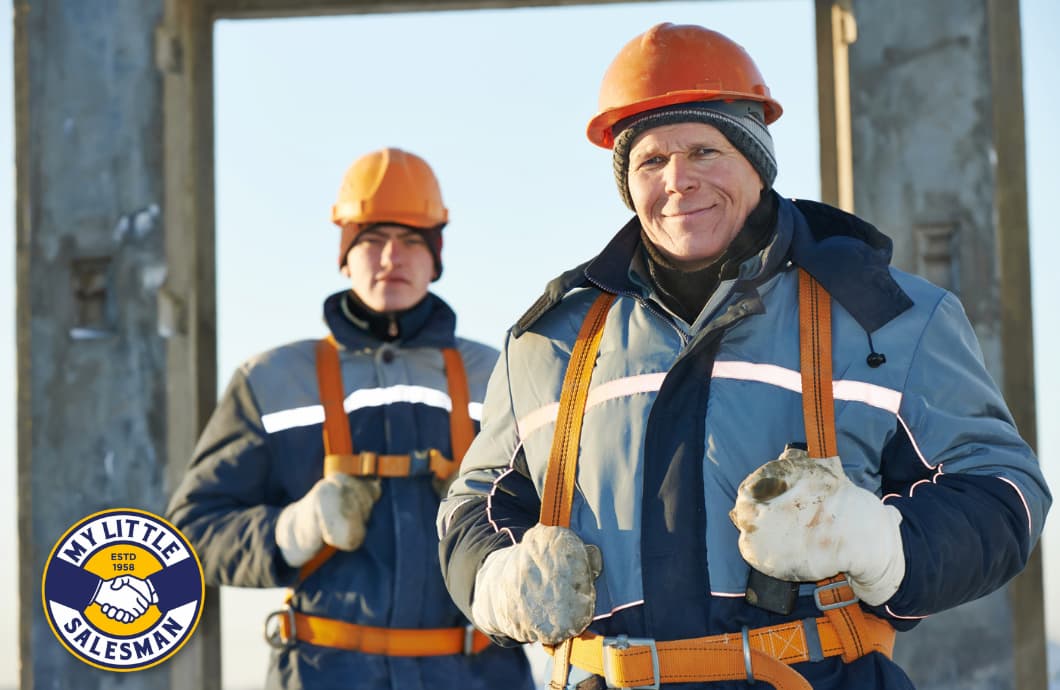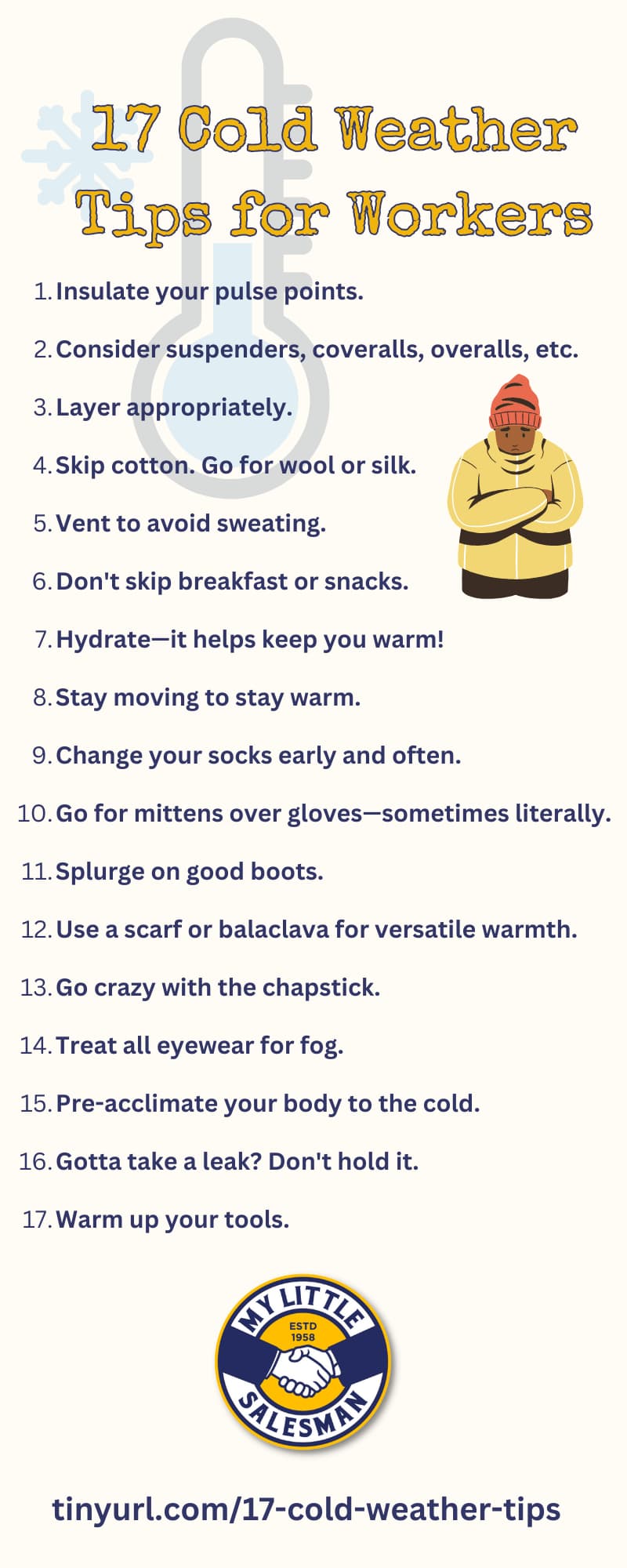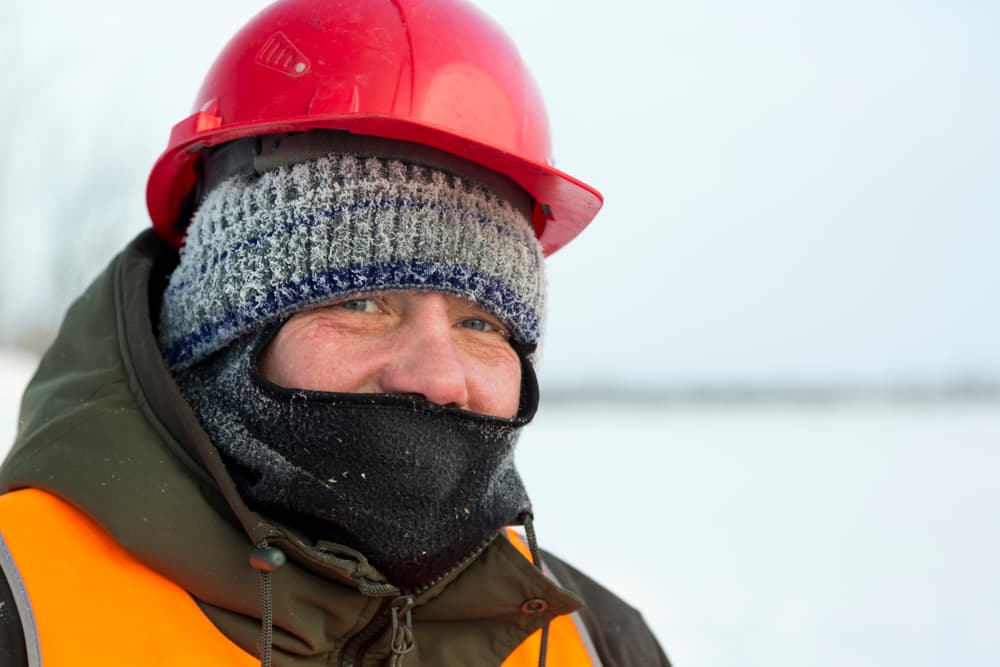
Guide Contents
Enjoy these cheat codes for staying warm for jobs in the cold.
Working outdoors in cold weather requires more than just grit—it requires smart strategies to stay warm and efficient. For this reason, we've gathered many lesser-known winter construction tips (or cold-weather working hacks, for folks that like the term "hacks"), not necessarily numbered, for staying warm when your job requires working for hours in the bitter cold.
For your convenience, we've generated this handy infographic fill with cold weather tips for you to reference.

Even the best cold-busting material is no match for a chink in your armor. For this reason, it pays to overlap the connection points in your cold-weather gear layers.
While an obvious one is your waist, where tucking shirts into pants is key, don’t forget your “pulse points,” wherever you can easily feel your pulse. These include your neck, wrists, ankles, and knees. Insulating these areas can help you feel considerably warmer on the site.
Side Tip: Choose suspenders over belts to seal in the heat.
Consider coveralls, overalls, or suspenders instead of belts to keep your pants up and your layers secured.
While a single heavy coat is an incredible tool for combating frigid temperatures if you need to go out in the cold for short errands, multiple layers fare better for longer stints in the cold. This is because the true hero is not cold protection. Rather, it is trapped, warm, insulating air.
While heavy coats contain their own warm air chambers, layered clothing provides various pockets of insulating air between each layer. Layered clothing also helps you to better dial in the necessary level of insulation, protection, and comfort by adding, removing, or replacing items of clothing—like carefully tweaking a thermostat.
Layers also make for a better fit across your body with fewer leak points—unlike heavy coats, which can let in drafts or let heat escape from the bottom, wrists, or neck.
Side Tip: Avoid cotton as much as possible.
The best materials for layers are genuine silk, wool, or moisture-wicking synthetic fabrics.
While keeping the exterior cold temperatures at bay is great, sweating under your cold-weather gear is not only uncomfortable, it’s also dangerous. When materials get wet, they fail to properly insulate, leaving you susceptible to discomfort or even hypothermia.
It may sound counterintuitive but, at the first sign of getting overly warm in your cold weather gear, regulate your temperature by letting your coat breathe a bit. You can also remove an unnecessary layer or two until you’ve reached a more comfortable temperature.
Side tip: Remember—you’re not aiming for “warm,” just less cold.
Our natural response to being in frigid temperatures is to attempt to become as warm as possible. Unfortunately, this causes us to become too warm, and sweat—and then we’re in real trouble. Instead of aiming to become warm, simply aim to become less cold.

Because food provides energy and energy becomes heat (which is why its often measured in “calories), eating and having food in your stomach is a great way to “stoke the fire” inside of your body to stay warm. So, not skipping breakfast before a shift in the cold and frequent snacking is a great way to beat the cold.
Side Tip: Drinking water keeps you warm.
While it sounds slightly counterintuitive, drinking enough water is a crucial part of staying warm in cold weather. Not only does it help your body better circulate warm blood and with your metabolic function but you can also see your dehydration occur before your very eyes in the form of exhaled fog clouds. That’s literally moisture leaving your body with every breath. So, drink up to stay warm!
Military Hack: One service member recommended a splash of Tabasco sauce in the coffee for a shot of warmth you’ll feel all over.
Sometimes, when it gets too cold, you just want to hunker down and stay still to remain warm. Well, biologically, that’s one of the worst ways to beat the cold. Instead, moving your body not only activates heat-emitting muscles but also increases the circulation of warm blood all over your body. This is why your body’s natural response to being overly cold is to shiver—which is just a method of generating excess body heat.
Side Tip: Hustle to heat.
If you’re feeling too cold, consider doing a few jumping jacks, air squats, or pushups to fire up those muscles as well as your metabolic engine.
.jpg)
Your hands, fingers, feet, and toes are all susceptible to discomfort or even injury from cold weather. The following are hacks from experienced cold-weather workers.
- Change your socks regularly. Because moisture is the enemy of warmth, it pays to have several pairs of wool socks around for quick changes every few hours or whenever they get wet. Keep them stashed all over and ready to be thrown on at the first sign of discomfort or anytime you take off your boots.
- Mittens over gloves. For jobs that require less dexterity, mittens allow your fingers to heat each other. If you absolutely need to use your fingers, however, wearing thinner gloves under your mittens is a good workaround.
- Good boots are worth the price. There are a few areas where you can afford to cheap out. Boots are not one of them. A reliable pair of cold-weather work boots can be the difference between a good day and a bad one. Also, consider if composite-material-toed boots may be a warm alternative to thermally conductive steel-toed boots. Weigh the pros and cons.

The following are cold-weather hacks from workers who have put in thousands of hours in bitterly cold temperatures. A special thanks to our good friends in Canada for most of these.
- Scarves & Balaclavas For the Win: Many make the mistake of overlooking the insulation and protection of the neck and face. For this reason, a long scarf or balaclava can be an immensely versatile piece of cold-weather kit to protect the neck and face from the cold.
- Chapstick—It’s Not Just For Your Lips: Many cold-weather workers swear by using chapstick on pretty much any exposed area for wind protection and combatting dry skin.
- Remember to De-Fog Your Specs: If you’re moving between temperatures, such as outdoors into a vehicle cab, it is important to treat your glasses or goggles with a de-fog solution beforehand.
- Acclimate to Cold Before You Get There: There is a temptation to roast the cab of a work truck on the way to a job site. However, gradually decreasing the cab temperature the closer you get will help to acclimate your body to the cold so you’re less miserable once the heated cab is nothing more than a memory further into the work day.
- Use the Restroom Often: There is a temptation to put off going to the bathroom when you need to in the cold—after all, those are a lot of layers to get through. However, holding it can make you feel colder. If you’ve ever been camping in winter, you can probably attest to the truth behind this.
- Use a Radiant Heater on Your Tools: This one is a bit of an old mechanic’s or farmer’s hack. However, many swear that using a radiant heater on your tools before use can make them more pleasant to use in bitterly cold temperatures—especially if you need to use them without gloves. This tip comes with a disclaimer to do so responsibly so you don’t risk damaging your tools or burning your hands.
Your Partner in Tough Conditions
For more tools and equipment to make your job easier in any weather, check out all of the new and used heavy equipment for sale listings from your friends at My Little Salesman.